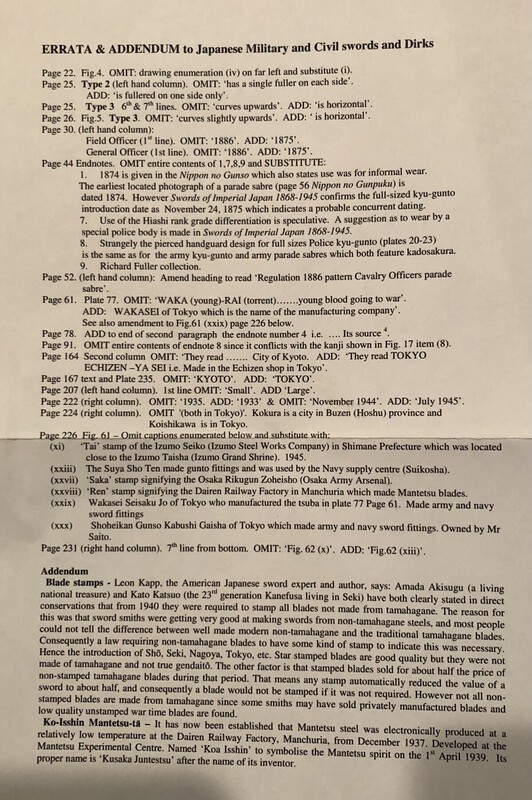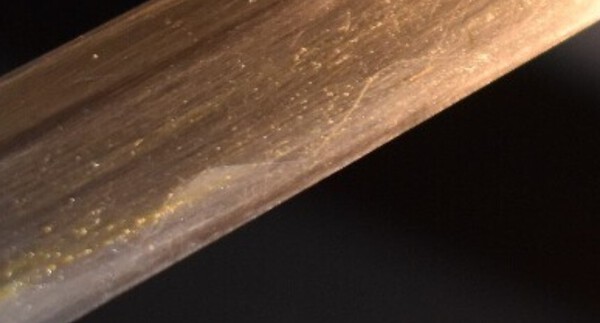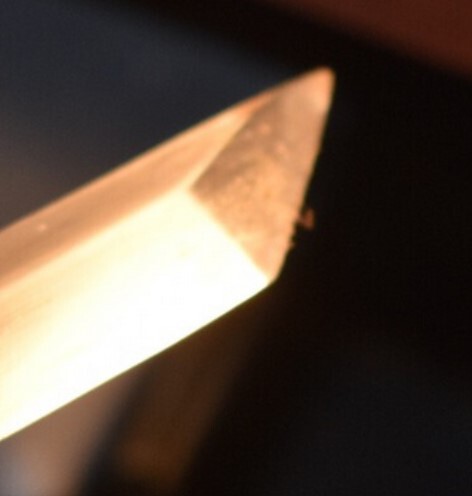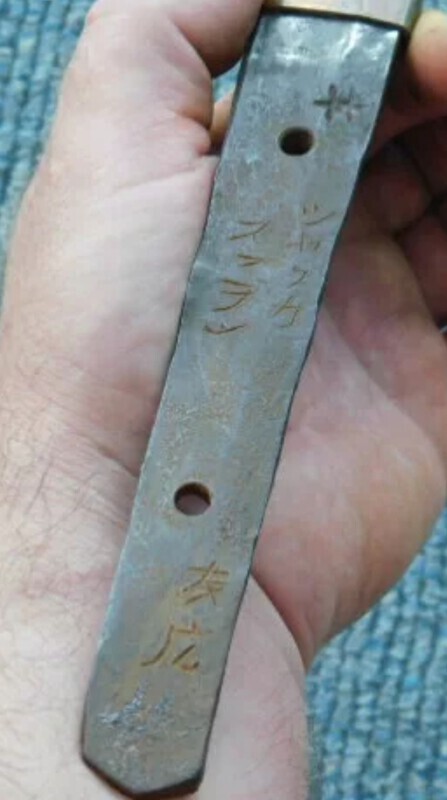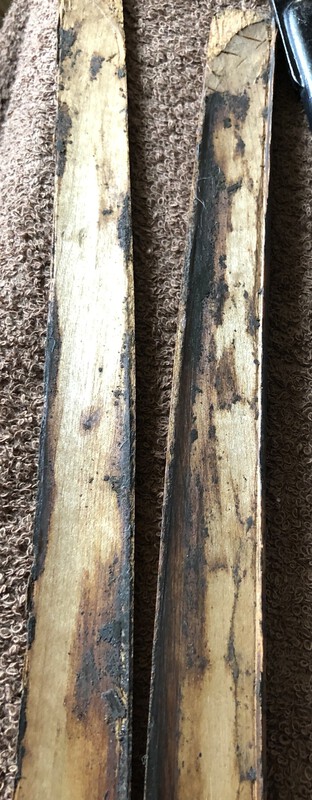-
Posts
13,105 -
Joined
-
Last visited
-
Days Won
157
Content Type
Profiles
Forums
Events
Store
Downloads
Gallery
Everything posted by Bruce Pennington
-
I would enjoy as many pages as you would share! Quite a document you have there, Neil!
-
I have a blade that had several dings in the edge where someone had whacked something really hard (like metal). You can't see the burrs in the photos, but they were there bad enough that I couldn't do uchiko without the paper snagging and ripping on the burrs. So I used a fine file to take the burrs down. On the mismatched saya, that is really quite common. We see more of those at the forum than matched ones, and I have one too. Regardless of how that happened, they are both WWII history are were part of the war. I would care for it with the same respect as with a matched set.
-

WWII officer's sword ID and info?
Bruce Pennington replied to Mad Dog's topic in Military Swords of Japan
Cal, Be sure to read these threads on the subject: and https://www.warrelics.eu/forum/Japanese-militaria/government-Japan-will-now-act-intermediary-case-you-wish-return-war-relics-families-679338-2/ I am no expert on the subject, but while the effort is good-hearted on your part, I've read mixed reviews on returned items. Sometimes the effect is healing, providing closure; but sometimes it causes anger and more pain. Sometimes the guy sees his item on ebay the next week after going to great pains, time, and expense to make the return. But in the end, I suppose it's like the story I heard - 2 guys walking by a wino-beggar. One guy gives him $5, and the other questions him about it. He says "It's in my heart to give. It's up to the beggar how he uses my gift." -

Attention Mantetsu Owners: A Survey
Bruce Pennington replied to Bruce Pennington's topic in Military Swords of Japan
Yes, Trystan, exact same 3 pictures, but thanks! -

WWII officer's sword ID and info?
Bruce Pennington replied to Mad Dog's topic in Military Swords of Japan
Cal, Is the cosmoline hard and dry? If so, that would added weight to the idea this sword was the item shipped. But it's still a Chinese fake. There were fakers, even U.S. and Aussie G.I.s making faked flags and swords DURING the war. So it wouldn't surprise me if the Chinese had their own element in the game. Or like Dave said, someone long after the war, even the Vet himself, could have traded the sword for another. The hamon (temper line) is clearly artificial And the blade tip is classic Chinese Here's a Japanese-made blade tip -
That real example definitely reinforces this issue! It's truly amazing what Richard Fuller and Ron Gregory achieved before the advent of the internet and forums like these. As soon as any book is published, there is already an errata sheet building full of corrections the authors could make. There is a similar sword ON THIS THREAD.
-

WWII officer's sword ID and info?
Bruce Pennington replied to Mad Dog's topic in Military Swords of Japan
Agree -
Luke, Robinalexander has gone through the process of making he own liner. You can read about his efforts and the woods discussed ON THIS THREAD.
-
Map, About halfway through, and you’ve added a lot of photos for my stamp survey! You might consider a smaller version, maybe less pictures, and post it in the JSSUS newsletter. I can give you an email for the editor. They’re always looking for articles.
-

First post, Type 3 Gunto. Remove rust to expose mark?
Bruce Pennington replied to DavidB's topic in Military Swords of Japan
David, you didn’t mention the fittings. If they are fancy, wooden with lacquer finish, even double release buttons, then this blade may be something nice by a nice Smith. But if it’s standard fittings, then it’s likely just a war blade and it wouldn’t hurt to remove rust to read the writing. On the other hand, as a standard war blade, removing the rust wouldn’t reveal much. Likely 1943, 1944 1945, and a Seki Smith. But as a war blade, no one would criticize you much for cleaning it enough to read the writing. -

Attention Mantetsu Owners: A Survey
Bruce Pennington replied to Bruce Pennington's topic in Military Swords of Japan
Nice one Thomas! It's now added to the study. -
Ha! Actually never heard that one! My middle name is Wayne, so I get a lot of Batman questions. Of course I have to deny that I’m him!
-
Good catch, Steve, on the handle wrap! Luke there’s a long discussion on the evolution of these here: https://www.warrelics.eu/forum/Japanese-militaria/short-development-history-type-95-gunto-676112-5/
-

Show Us Your High Class Gunto
Bruce Pennington replied to lonely panet's topic in Military Swords of Japan
Cool Trystan, thanks! Sorry Neil, ..... and back to the show! -

Show Us Your High Class Gunto
Bruce Pennington replied to lonely panet's topic in Military Swords of Japan
That’s honestly very kind of you Trystan, but I can’t read your Japanese print any better than I can read Japanese in the Nakago! -
So much reading, so little time!!! Looking forward to it, guys, thanks!
-
On the philosophy: I agree with those who view these as history, and we are preserving history. As such, I don't re-paint anymore, but I do replace missing parts and add missing tassels (period of course). But these are weapons. No one would leave an Arisaka or Nambu in "as-is" condition, with all the dirt and grime in the chamber, bolts and firing mechanisms. Neither will I leave my weapons in such degraded condition just because they are swords.
-
Luke, Welcome to the club! Is that a small remnant of a leather saya cover? If so, too bad it was destroyed. Type 95s with leather covers are hard to find! By the looks of the rust on the saya, this baby probably spent some time in very humid tropics, which decomposed the leather and started eating the saya and blade. On restoration: I've been down that road a couple of times already. I had 2 Type 95s painted gold and black. The late-war 95 had the original paint underneath and I was able to remove the modern paint with acetone, so a success. The early 95 had been stripped to bare metal and spray-painted gold. Even the blade was painted a translucent gold! I stripped it and couldn't bear leaving it bare, so I had a buddy, who paints models, do the tsuka and I painted the saya. It's a far cry better off now than with the gold paint, but it's too new looking and the colors stand out as wrong when next to original paint. For me, it was the lesser of 2 evils, and I'm glad I did it, but it's still sad to see. After all said and done, if I had yours I'd lightly remove active rust, oil to prevent future rust, then leave as is. Here's the thread where we discussed my process, with some links to recommended paints. Any tips for Period Re-Paint? On disassembly: When you remove the tsuka on a 95 and re-assemble, about half the time, you'll have some wiggle that wasn't there originally. That bothers some guys, so consider it before you proceed. I have 9 95s and have broken each down for cleaning and oiling. There's often some serious gunk around the seppa and other fittings. You have to carefully bend the sarute (I use 2 pliers with thick clothes in the mouths to avoid scratching the sarute metal) to get it off. That frees the barrel screw at the end of the tsuka. Be careful with both the barrel screw and the lower screw. The metal is moderately soft and easy to bugger up if the screwdriver slips. The lower nut requires a 2-hole driver bit, or a 2-hole plier to hold the nut. I don't recommend sanding the blade, even the finest grit shows in the finished surface. Lemon juice + baking soda makes a mix that will help kill and remove some of the rust. Don't use it on the seppa or fittings as it will also remove original paint and patina. 90%+ alcohol will put a little shine on the blade when your done. Get a good uchiko cleaning kit, and clean the heck out of the blade with it. Oil and wipe down all the parts before re-assembly, and done. Oh, don't use Brasso on the copper fittings, it will Totally strip the original finish! Like the guys said, other than a small arsenal stamp, or an occasional "W" stamp, you won't find anything on the nakago. With a badly pitted blade, I have found that the wooden liners were corroded inside as well. Those I sand down with copper-wool and smooth out completely.
-

Show Us Your High Class Gunto
Bruce Pennington replied to lonely panet's topic in Military Swords of Japan
Forget the blade! I need the translation for the Kakihan!!! Ha! Just kidding (ok, maybe not!). Classic Neil-style drop dead gorgeous! Someone spent a pretty penny fitting this one out. I got the date down: Manji 3, so 1660, Nov 10th. Will need help with the rest though! -

Need Help with a Katakana
Bruce Pennington replied to Bruce Pennington's topic in Translation Assistance
Thanks George. By all appearances, stamping went regional after the Army assumed control of all sword production in 1942. These would make sense, in that context, as regional stamps and this information about the "Eastern" Sword Forging Assoc. fits in nicely. The Matsu stamp started in 1942 as well, so it would be convenient if a regional tie could be found. The katakana begin in 1944, but seem possible to be tied to locations too, and it would be cool to find that they are all tied to this Association. To explore some more, are these smith, whose numbers don't have a symbol in front of the numbers, located elsewhere: Tomomaro 535 Riyuu 1301 Morinobu 95 Munimitsu 315 Akitaka 1098 Munetaka 490 Katsumara 1512 -
Neil, I saw that one too, but these are pretty specific. Slight variations in the pattern signify different things. Dawson's has 3 levels of the rays - outer, middle, inner - whereas this tanto only has 2 levels.
-
Neil, Does this blade have any stamps? The reason I ask, is that in one of Ohmura's discussions, he mentions "tosho mei with saka or na stamps" (these along with star-stamped blades are always gendaito, he says).




